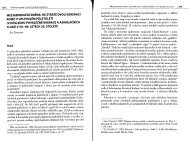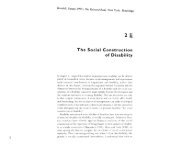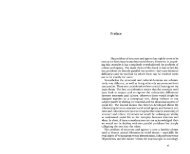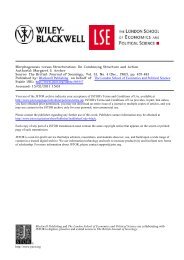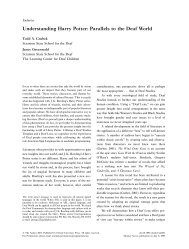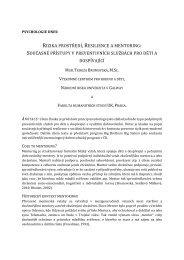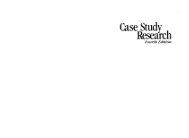Culture and Practical Reason Two Paradigms of ... - Moodle
Culture and Practical Reason Two Paradigms of ... - Moodle
Culture and Practical Reason Two Paradigms of ... - Moodle
- No tags were found...
You also want an ePaper? Increase the reach of your titles
YUMPU automatically turns print PDFs into web optimized ePapers that Google loves.
Chapter <strong>Two</strong> 104 <strong>Culture</strong> <strong>and</strong> <strong>Practical</strong> <strong>Reason</strong><strong>Two</strong> <strong>Paradigms</strong> <strong>of</strong> Anthropological Theory105exposing reality to view. The human power <strong>of</strong> bestowing meaning-<strong>of</strong>experiencing as meaning-constructs another kind <strong>of</strong> world:Man differs from the apes, <strong>and</strong> indeed all other living creatures so faras we know, in that he is capable <strong>of</strong> symbolic behavior. With wordsman creates a new world, a world <strong>of</strong> ideas <strong>and</strong> philosophies. In thisworld man lives just as truly as in the physical world <strong>of</strong> his senses.Indeed, man feels that the essential quality <strong>of</strong> his existence consists inhis occupancy <strong>of</strong> this world <strong>of</strong> symbols <strong>and</strong> ideas-or, as he sometimescalls it. the world <strong>of</strong> the mind or spirit. This world <strong>of</strong> ideascomes to have a continuity <strong>and</strong> a pennanence that the external world<strong>of</strong> the senses can never have. It is not made up <strong>of</strong> the present only but<strong>of</strong> a past <strong>and</strong> a future as well. Temporally, it is not a succession <strong>of</strong>disconnected episodes. but a continuum extending to infinity in bothdirections, from eternity to eternity. [White 1942, p. 372]But then from this symbolist perspective-as opposed to the positivist<strong>and</strong> utilitarian consciousness through technological disclosure-the tool isitself an idea. It is "not merely a material object, or even a sensory imageas it may be to an ape. It is also an idea" (White 1942, p. 373). If a stoneax generates a given type <strong>of</strong> philosophy, nevertheless the ax itself is aconcept whose meaning <strong>and</strong> use, as is true <strong>of</strong> all concepts, are fixed not byits objective properties but by the system <strong>of</strong> relationships between symbols.Thus the technological detennination <strong>of</strong> culture in White's evolutionarytheory lives side by side with the cultural detennination <strong>of</strong> technologyin his symbolic theory:An axe has a subjective component; it would be meaningless without aconcept <strong>and</strong> an attitude. On the other h<strong>and</strong>, a concept or an attitudewould be meaningless without overt expression, in behavior or speech(which is a fonn <strong>of</strong> behavior). Every cultural element, every culturaltrait, therefore, has a subjective <strong>and</strong> an objective aspect. But conceptions,attitudes, <strong>and</strong> sentiments-phenomena that have their locus WIthinthe human organism-may be 'considered for purposes <strong>of</strong> scientificinterpretation in an extrasomatic context, i.e., in tenns <strong>of</strong> their relationto other symboled things <strong>and</strong> events rather than in tenns <strong>of</strong> their relationshipto the human organism .... [Thus an axe may be considered intenns <strong>of</strong> its relationship] to other symboled things <strong>and</strong> events such asarrows, hoes, <strong>and</strong> customs regulating the division <strong>of</strong> labor in society.[White 1959a, p. 236]3636. In this anicle, White unnecessarily gives culture a contextual definition; namely, "symbolates"viewed in the context <strong>of</strong> other "symbolates," which puts the burden <strong>of</strong> thedetennination on the anthropologist-even as the locus <strong>of</strong> the symbolic remains in theAs against the fundamentally practical <strong>and</strong> technological paradigmwhich connects him with Morgan, White is thus capable <strong>of</strong> a symbolicperspective-which puts him in unlikely company. Allow me to juxtaposea passage previously cited from Levi-Strauss with a text from White'spresidential address to the anthropology section <strong>of</strong> the AAAS:WhiteThus [with symbols] man built anew world in which to live. To besure, he still trod the earth, felt thewind against his cheek, or heard itsigh among the pines; he drankfrom streams, slept beneath thestars, <strong>and</strong> awoke to greet the sun.But it was not the same sun! No-thing was the same any more. Everythingwas "bathed in celestiallight"; <strong>and</strong> there were "intimations<strong>of</strong> immortality" on every h<strong>and</strong>.Water was not merely something toquench thirst; it could bestow thelife everlasting. Between man <strong>and</strong>nature hung the veil <strong>of</strong>culture, <strong>and</strong>he could see nothing save throughthis medium. He still used hissenses. He chipped stone, chaseddeer, mated <strong>and</strong> begat <strong>of</strong>fspring.But permeating everything was theessence <strong>of</strong>words: the meanings <strong>and</strong>values that lay beyond the senses.And these meanings <strong>and</strong> valuesguided him-in addition to hissenses--<strong>and</strong> <strong>of</strong>ten took precedenceover them. [1958 ms; emphasismineJ31Uvi-StraussIf, as I have said, the conceptualscheme governs <strong>and</strong> defines practices,it is because these, which theethnologist studies as discreterealities placed in time <strong>and</strong> space<strong>and</strong> distinctive in their particularmodes <strong>of</strong> life <strong>and</strong> fonns <strong>of</strong> civilization,are not to be confused withpraxis which ... constitutes the.fundamental totality for the sciences<strong>of</strong> man.... Without questioningthe undoubted primacy <strong>of</strong>infrastructures, I believe that thereis always a mediator betweenpraxis <strong>and</strong> practices, namely theconceptual scheme by the operation<strong>of</strong> which matter <strong>and</strong> form, neitherwith any independent existence arerealized as structures, that is as entitieswhich are both empirical <strong>and</strong>intelligible. [1966. p. 130; emphasismine]human subject-<strong>and</strong> ignores the real process by which human productions are reified or"objectivized," i.e., become "extrasomatic." See Berger <strong>and</strong> Luckmann (1967) for arecent discussion <strong>of</strong> "objectivation," tied, however, to just-so origins in praxis.37. The comparison is admittedly mildly disingenuous, for the final sentence <strong>of</strong> White'sparagraph is a proposition which Levi-SlraUSS would nol endorse, although it is Ie propre<strong>of</strong> Boasianism: "Man had become the irrational animal."



